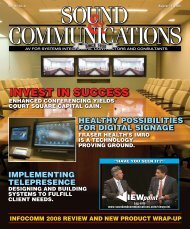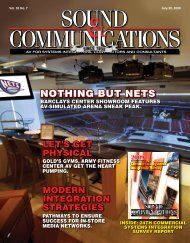May 2009 - Sound & Communications
May 2009 - Sound & Communications
May 2009 - Sound & Communications
Create successful ePaper yourself
Turn your PDF publications into a flip-book with our unique Google optimized e-Paper software.
Rx For Success ConclusionIndustry ‘illnesses’ eat into profits.By Robin ParkerEditor’s Note: Part 1 appeared inour January <strong>2009</strong> issue.As a project increases in scope,entirely new factors enter into thelabor equation, yet they may beoverlooked, never considered or,worse, ignored. These are (butcertainly are not limited to): materialhandling and transportationtime, waste management, fatigue,boredom, smoke breaks...I can keepgoing if you’d like. There are virtuallythousands of invisible labor killers.Individually, and on the surface,these may not seem like much, but,added up at the end of a major project,their cost can be staggering.Just the simple act of transferring50 boxes of speakers from the shop,to the truck, to the jobsite and findinga place to get set up takes a stupidamount of unplanned time. Oh,and there’s no freight elevator, andthe job’s on the sixth floor, and theydon’t want you to use the passengerelevators until after 5:00pm.Waste disposal time is neverfactored into job cost. At sheerface value, how long does it taketo unbox and dispose of the trashfor those 100 speakers, from thesixth floor? This single element caneasily add another stupid amountof man-hours to a project. I have asimple rule: I don’t transport trash,unless absolutely necessary: Youcan’t install it. A “stupid amount”is a variable, yet massive, number ofunplanned-for man-hours.I did a test of this theory at a majorschool project by simply un-packagingseveral cables required in eachclassroom. Note that there was nospecific time applied to perform thisDenying the reality ofpast mistakes that costtime and money is onlybegging for them tohappen again.task of unboxing, unwrapping anddisposing of the trash of some 500cables. It took three people, workingat top speed in a production-linemanner, slightly more than threehours, or nine man-hours, and thiswas working at a breakneck speed.It was assumed that these cableswould be taken (in their originalpackaging) into each classroom,unwrapped and installed. (Now itdoesn’t take time to do this, does it?)If it takes nine hours to performa simple repetitive task in a controlled,production line-like manner,how long do you think it will take toperform the same task collectivelyacross the entire course of a projectif done individually? My estimate isfour to six times longer. Now, applythis to the bottom line of a job andyou have a situation in which atleast one full man-week has beenadded to a project for an issue thatreceived absolutely no attention inthe first place. I have done the sameanalysis in other aspects of differentinstallations, as well.Yes, I have made a study of this.Being a (literally) one-man operation,I am provided with a uniqueopportunity not only to see, but alsoto experience firsthand, each andevery nuance of a project and the interrelationshipof each department.To this point, if the salesman (me)forgets something, or the stockclerk (me) doesn’t order the correctthing, the field installer (me) feelsthis directly. I can (mentally) contactthe project manager (me) and havehim bless out the project engineer(you’ve got it, Bucko, me) who, inturn, will have words with all othersinvolved (me). The company owner(me) gets a field report and costoverrun expense statement immediately.This short “straight path,” if youwill, has distinct advantages. Therelaying of pertinent informationto all parties is pretty much instantaneous.What also occurs in thatsame instant is the absolute anddirect impact of additional cost. Itis at this moment that I realize thata missing $6.00 widget is going tostop the project, require a trip toHome Depot or, worse, have to beordered in—rush—and now potentiallycost into the hundreds ofdollars (of my money).Robin Parker, owner of Suffolk Audio Services, has more than 30 years of experience in theprofessional audio/video industry. He has been involved with the design and installation ofhundreds of systems in the Mid-Atlantic region and worldwide.36 <strong>Sound</strong> & <strong>Communications</strong>www.soundandcommunications.com
















